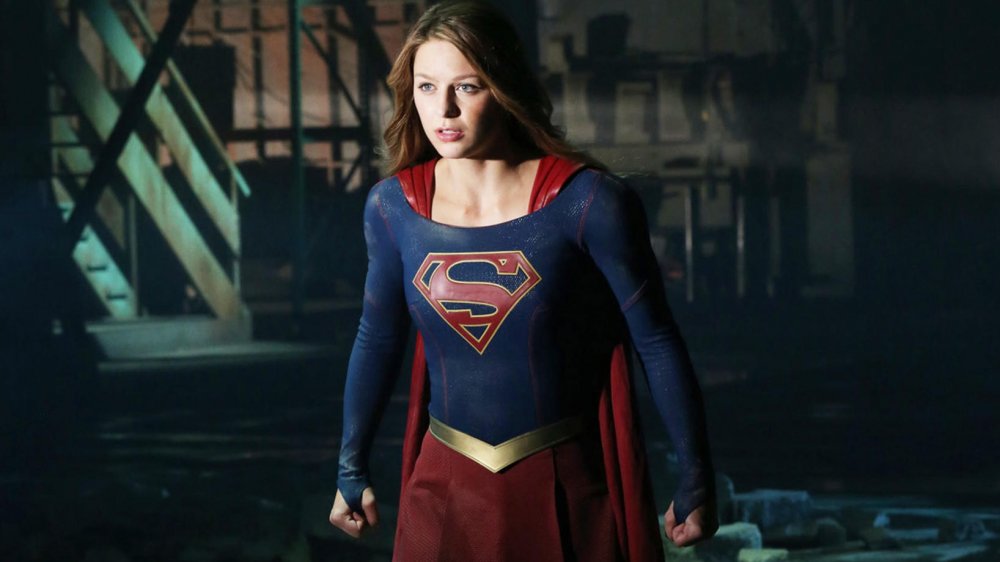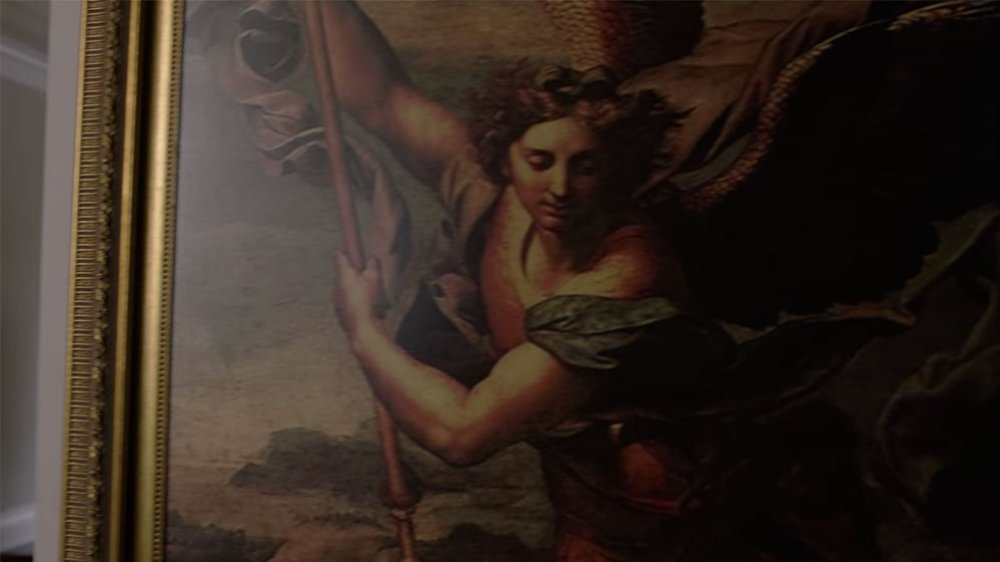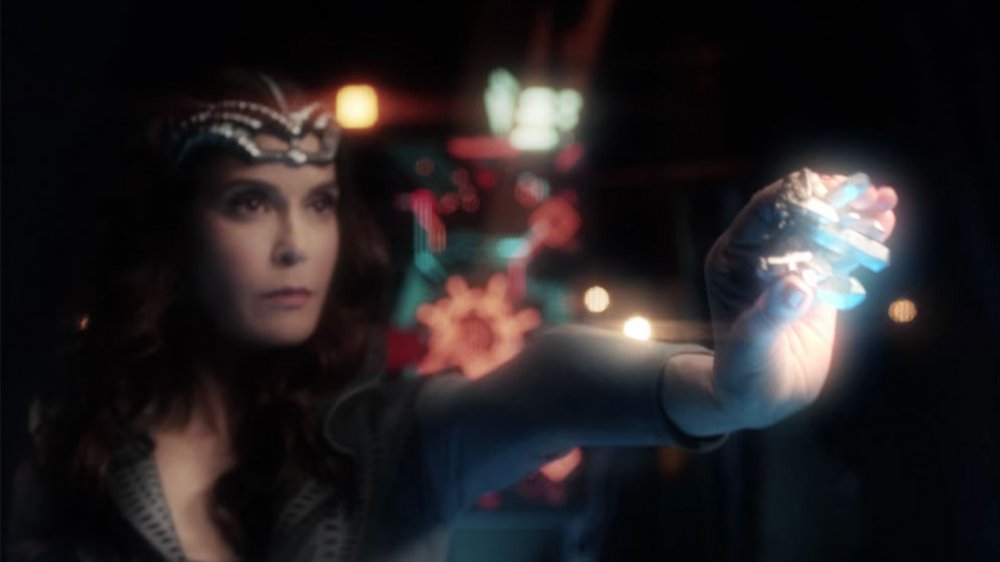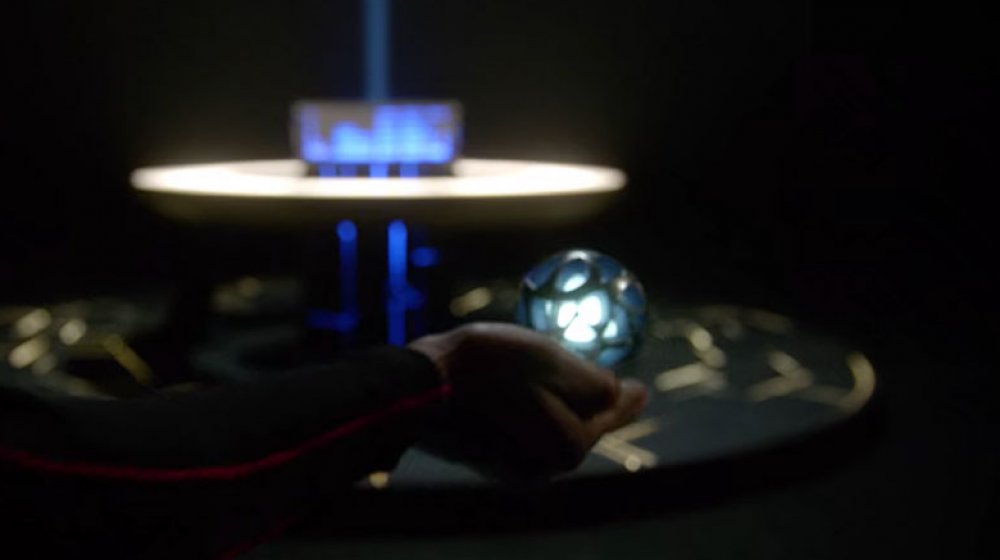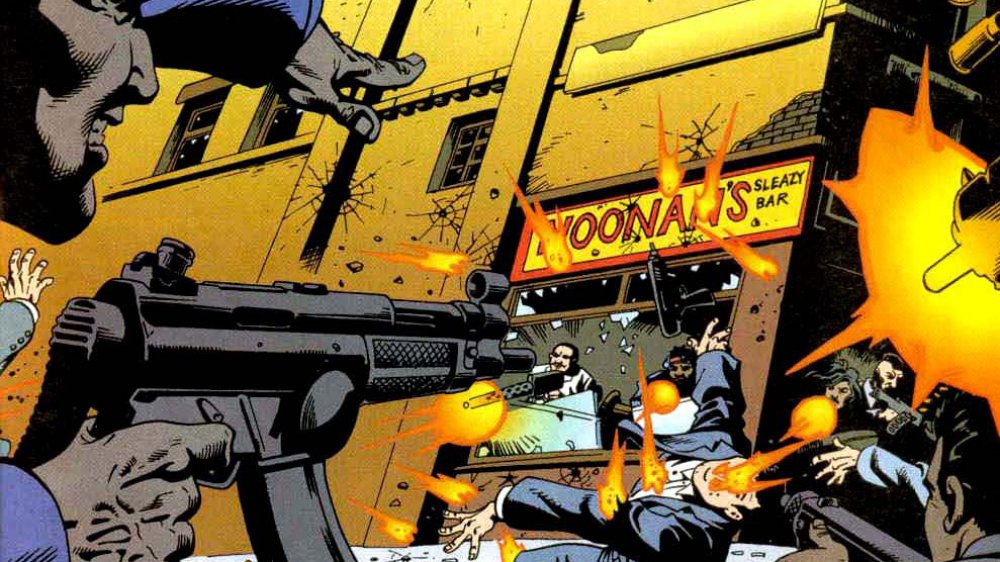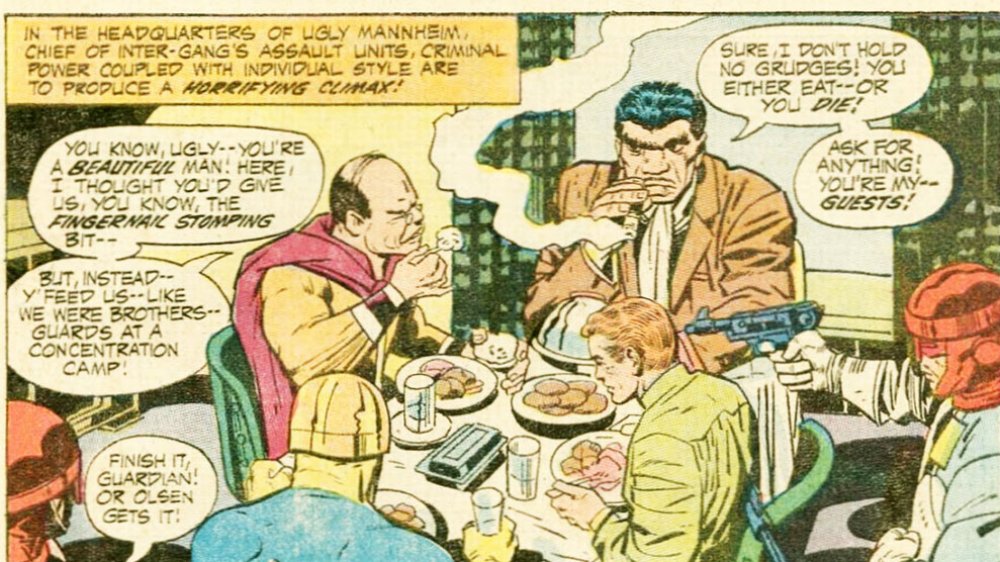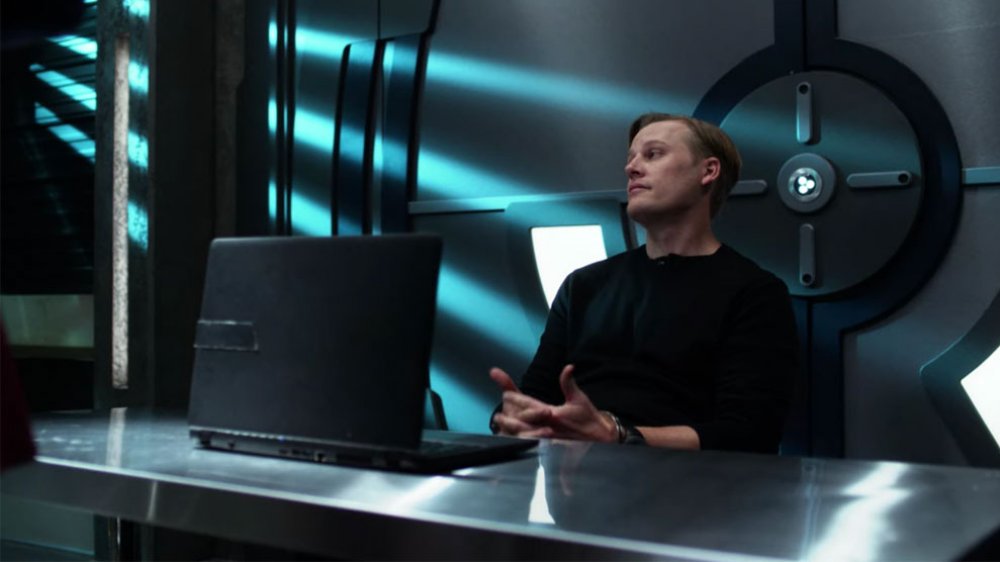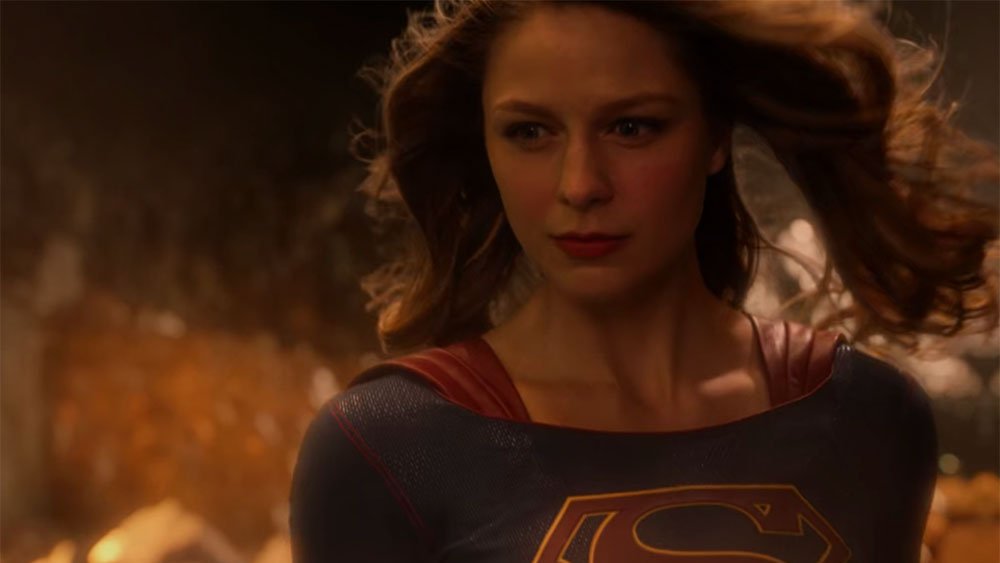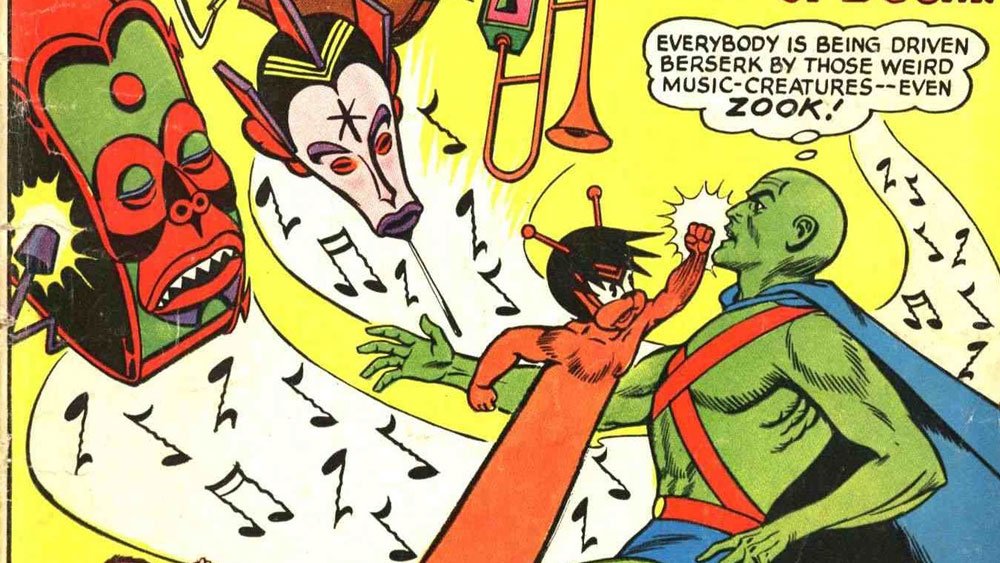Easter Eggs In Supergirl Only Real Fans Noticed
Let's face it, friends: we live in a world where there's no such thing as an obscure superhero reference anymore. Rocket Raccoon is a household name. Topo the drumming octopus showed up in a blockbuster hit Aquaman movie. There was a movie where Captain America traveled back in time and fought himself to get one of the Infinity Gems last year, and everyone in the world saw it.
But maybe that just means that the people behind all those superhero shows that have jumped off the comic book page and onto the big screen need to dig a little deeper, and with a couple dozen episodes every year to work with, TV shows like Supergirl give them the opportunity to do just that. From rare strains of Kryptonite to the Martian Manhunter's imaginary friend to a Gotham City franchise opening up a new branch, here are the Supergirl Easter eggs that were definitely put there for the diehards.
If it's just a city, is it really National?
Since its debut in 2015, Supergirl has found an audience by focusing on a more accessible version of the DC Universe that's easy for casual viewers to get a handle on. After all, everybody knows Superman, right? Here's his cousin, she's got the same powers, does the same stuff, is a similarly good and charming person, let's go have adventures! With that in mind, it might be surprising to learn that one of the show's most deep-cut references comes from one of the very first things we learn about the show: its setting.
It's easy to think that Kara Danvers' adopted hometown of National City has a standard issue generic name like most of the other fictional towns in the DC Universe. Gotham is just an old nickname for New York, and Metropolis is literally just a word that means "city," a feat of vague naming that's only matched by Smallville, which is small. Unlike those, however, National City doesn't have its roots in comics. While it was eventually introduced into the DC Universe, it was created for the show, and its name has a meaning that goes a little deeper than just being a city within a nation, which many, if not most, cities are.
Instead, National City is a reference to Supergirl's publisher. The fact that "DC" stands for "Detective Comics" is pretty well-known — meaning that yes, "DC Comics" is actually "Detective Comics Comics" — but fewer people know that this wasn't actually the company's official name until the late '70s. Before that, they were National Periodical Publications, and before that, it was National Comics Publications, National Allied Newspaper Syndicate, and, well, you get the idea. It's nice nod to the character's history, since National was still the company's name when Supergirl was introduced in 1959, but it's pretty obscure. If only there was some major city they could've used with some connection to the letters "D.C."
He doesn't know art, but he knows what he likes
In "Shelter From the Storm," the 18th episode of Supergirl's third season, Kara, Alex, Mon-El, and Reign all take a trip to Lex Luthor's mansion. As you might expect, his interior decorating tastes mostly lean towards deathtraps meant to kill Superman, but it's not all flamethrowers and chunks of Kryptonite. Eventually, a brawl starts up down in Lex's old Nefarium — that's what he used to call his lair in the '70s — and we get a pretty good look at his art collection when Supergirl and Reign start knocking each other through paintings.
Fortunately, Lex kept one important piece of art upstairs, out of harm's way: Saint Michael Vanquishing Satan, by Raphael. In real life, it's a priceless work of art that hangs in the Louvre, and considering that it's literally a painting of good triumphing over evil, it seems like an odd choice for Lex Luthor. You'd think he'd want something where the bad guys were winning for a change, even if he had to get it from one of the lesser Ninja Turtles.
There is, however, a reason for it to be there, and it has nothing to do with Lex's taste in art — at least, not on the show. Instead, it's a callback to Batman v Superman: Dawn of Justice, where Lex has a version of the same scene hanging in his office. It's a different piece — BvS used a more dramatic version by Gustav Doré called "The Fall of the Rebel Angels," and hangs it upside down to depict Satan descending from the sky, which Jesse Eisenberg skitters his way through explaining a couple times in case you missed the metaphor there — but it's a depiction of the same scene. Turns out Lex's tastes are pretty consistent, no matter what universe he's in.
Silver rage
Most people are familiar with Kryptonite — the word itself has moved well past its origins to become a synonym for any weakness, finally letting Achilles lay down his linguistic burden after about 3,000 years — and most comic book fans are aware that the familiar Green Kryptonite is only one of several types that have shown up in comics through the years. Supergirl has tapped into this long tradition, too, digging up Blue, Red, and even "Synthetic" Kryptonite, all of which have their origins in the comics.
In the finale of season 2, however, the show busts out a pretty obscure one: Silver Kryptonite, which first appeared in 1963's Superman's Pal Jimmy Olsen #70. Well, except that it didn't, because it wasn't actually real. Less real than all the other stuff. C'mon, you know what we mean. In "The Secret of the Silver Kryptonite," Jimmy tricked Superman into being worried about a strange new strain with unknown effects, only for it to turn out as a hoax. It was silver for Superman's silver anniversary — the story was meant to mark 25 years since the Man of Steel's debut in 1938.
The version we see on Supergirl, however, is very real (you know what we mean), and can cause paranoia and hallucinations. In Kara's case, that means that her cousin Clark attacks her because he thinks she's General Zod, but this version has a precedent, too. It's actually a reference to the CW's previous long-running Super-show, Smallville, where it showed up in season 5 with a similar effect on that show's version of Clark Kent.
The Omegahedron
You'd expect Supergirl to have plenty of references to the old Richard Donner/Christopher Reeve Superman movies, since virtually every piece of the Superman franchise since 1978 has made some kind of attempt to recapture the cinematic magic that made audiences believe that a man could fly. What you might not have expected was that they'd build huge plot points around elements lifted from the Supergirl movie.
Kara's 1984 cinematic outing is often forgotten by fans, and — despite the fact that star Helen Slater made a fantastic Supergirl in her own right, and would wind up playing Kara's adoptive mom on the TV show — was honestly not very good. The inconsistent, confusing plot was largely built around a Kryptonian McGuffin called the Omegahedron, which had the vague power to... well, whatever the plot required, really. Chasing it down was what led to Earth, and the bad guys mainly wanted to use it for evil magic spells, which, you know, sure, whatever.
Cut to 35 years later, and the show brings in the Omegahedron as a major plot device in its first season. Not only was it used by Non — another one of those imports from the Donner movies — to rebuild Indigo, it was also the power source for Myriad, the mind-controlling program that Supergirl faced off against in the first season finale. Like the movie, the show kept the limits of the Omegahedron's abilities pretty vague, but they did identify it as a Kryptonian power source, explaining why Myriad was so powerful that it could even affect Superman.
Noonan's
Supergirl is obviously chock full of ideas and elements pulled from the Superman comics — like, say, the character of Supergirl — and with Lynda Carter appearing as President Marsdin, there are more than a few nods to Wonder Woman, too. There's even a couple of references to Batman, but you might be surprised to learn that the show's most prominent pull from Gotham City has very little to do with the Dark Knight. Instead, it comes from the pages of Hitman.
Created by Garth Ennis and John McCrea, Tommy Monaghan was originally created as part of the Bloodlines event, in which every DC Comic of the time introduced a brand new hero or villain to the universe, in the hopes of striking gold with the new sensational character find of 1993. If you're wondering why you've never heard of, say, Shadowstryke, Razorsharp, or Ballistic, it's because Tommy, a working-class hitman for hire whose powers gave him a headache when he tried to use them, was the only one who was any good. For some reason, Gunfire, the man who could turn anything into a gun, didn't click with audiences.
What does this have to do with Supergirl? Well, Tommy was from a neighborhood in Gotham City called the Cauldron, where his main hangout was a bar called Noonan's. If you're a fan of Supergirl, you might recognize that as the name of the restaurant where Kara worked as a waitress before being hired by Cat Grant. The show's brightly lit, family friendly dining establishment is a far cry from a dive bar frequented by hired killers with a literal demon named Baytor as a bartender, but when it comes to naming places on a superhero show, there's no such thing as coincidence.
Incidentally, this one actually has a reference within a reference: one of the most memorable scenes set in Supergirl's version of Noonan's comes from the season 1 episode "Falling." When Kara is exposed to Red Kryptonite and briefly becomes a jerk, she flicks peanuts at a shelf of bottles behind the bar, shattering them. If you're a super-cinephile, you'll recognize that as a direct recreation of a scene from Superman III, a genuinely great bit of a movie that we can almost guarantee is better than you remember.
Who you callin' ugly?
Superman's foes are every bit as legendary as the hero himself, a terrifying gallery of rogues who can threaten even a seemingly invulnerable Kryptonian. Lex Luthor, the brilliant billionaire scientist who could've saved the world a dozen times over if he wasn't so obsessed with owning it all for himself. Brainiac, the sinister artificial intelligence who obliterates entire civilizations, keeping their last survivors imprisoned in "bottle cities" after declaring their home worlds redundant. Darkseid, the god of evil, who rules over the fallen planet Apokolips. And who could forget Bruno Mannheim, a man who does crimes?
If that last one doesn't ring a bell, you might want to dig through some back issues. While he hasn't shown up yet, Mannheim's name is referenced a couple of times in season 4 as one of Lex Luthor's criminal associates. In the comics, he's a slightly bigger deal.
Created by the legendary Jack Kirby — who also created Etrigan the Demon, the New Gods, and, you know, most of the Marvel Universe — Bruno "Ugly" Mannheim was the resident boss of organized crime in Metropolis back in the days when Lex Luthor was more of a costumed mad scientist than a "legitimate businessman." Despite his rather unfortunate (and accurate) nickname, he was a pretty formidable character. He became one of the bosses of Intergang, an international crime syndicate that was the evil version of INTERPOL, the real-world international police organization. In that role, he was essentially a front for Darkseid to funnel Apokoliptian weapons onto Earth without being seen to directly interfere with humanity. According to Supergirl, he's in jail for now, but he could always be a pretty big player in the future. Supergirl's going to need a new big bad next season, after all.
Rickin' around
One of the great things about a show like Supergirl is that with so much time to work with over the course of several seasons and so much history for one of the best characters in comics, the creators can really dig back into the past and reintroduce forgotten elements of a character.
Take, for instance, Rick Malverne. Even on the show, he's not the most prominent character; only one appearance outside of a flashback, in season 2's "Alex." There, he's depicted as a childhood friend of Kara's who learned her secret back in their school days, but kept it to himself until he was an adult, using that knowledge to kidnap Alex and manipulate Supergirl into breaking his father out of prison.
Unless you've read a bunch of Supergirl comics from 50 years ago, you might've missed that Rick is actually from the comics, although he's a very different character there. On the page, Dick Malverne (can't imagine why they changed the name) was Supergirl's version of Lois Lane or, more accurately, Lana Lang: the childhood friend who suspected Supergirl's secret identity and kept trying to get her to reveal it. In Dick's case, this once escalated into literally faking his own death. Like his TV counterpart, it was later revealed that Dick had always known Supergirl's identity for a fact, and his elaborate plans were his way of dunking on the girl he had a crush on. Truly, a character who lives up to his name.
Supergirl Lives!
There are plenty of references to comics to be found in dialogue throughout Supergirl, but on the off chance that you haven't noticed, there's also a reference in most of the episode titles throughout the series. Perhaps surprisingly, most of them are actually lifted from real-world events. The second season finale, for instance, was called "Nevertheless, She Persisted," which, in addition to accurately describing Supergirl's own never-say-die attitude, was lifted from Senator Mitch McConnell's inadvertently galvanizing remarks about Senator Elizabeth Warren.
A few episodes earlier, however, we got one that was a Matryoshka doll of deep-cut comics references: "Supergirl Lives." Superman Lives! was, of course, the title of the 1993 young adult novelization of the Death of Superman storyline, authored by comics writer Louise Simonson with an extremely dope cover illustration by Alex Ross. It's probably more relevant, however, that there was once a movie in development with the same title, And yes: it's that Superman movie. The one that Tim Burton was going to make, with Nicolas Cage in a glorious mullet wig and that amazingly weird Batman & Robin-style muscle suit. All things considered, it's probably a good thing that movie never happened, but we can't help but wish we could've seen how completely buck wild that movie would've been if it had been made.
There's another layer to the reference, though. "Supergirl Lives" was directed by podcaster, filmmaker, and occasional comic book writer Kevin Smith, who wrote the screenplay for Superman Lives and has frequently spoken about the experience. If that's not deep enough, the episode does contain an offhand reference to a "Thanagarian Snare Beast," the giant spider that producer Jon Peters insisted Smith include at the climax of the Superman Lives screenplay. Sadly, Kara doesn't actually fight one in the show.
Zook
It won't blow anybody's mind to learn that most of the characters we see on Supergirl, especially the ones who run around in costumes, are from the comics. Guardian? He's from the comics (although he's never been Jimmy Olsen). Indigo? She's from the comics! The Martian Manhunter? That dude's been on the Justice League since 1961, you know he's from the comics!
Here's one that might actually surprise you, though. Remember Zook, the imaginary friend that J'onn mentions having when he was a kid back on Mars? Yeah, he's from the comics. No, really. In the Silver Age, there was a very weird trend of superheroes having weird little magical imps showing up in their stories to cause wacky troubles. Obviously, the most famous (and the one who got the whole trend started) is Superman's fifth-dimensional foe Mr. Mxyzptlk, who appeared on Supergirl in season 2, and you've probably heard of Bat-Mite, the Dark Knight's biggest fan.
Those are just the well-known tips of the inter-dimensional iceberg, though. Aquaman was annoyed by a sprite named Qwisp, who had a twin brother named Quink. The Flash even had one, Mopee, a "guardian angel" who was revealed to have been completely responsible for Barry Allen getting his powers in a story that fans hated so much that it was immediately retconned out of existence. Zook, on the other hand, managed to rack up 18 appearances in the Silver Age as a full-on sidekick before being shuffled off into the limbo of things we don't talk about.
